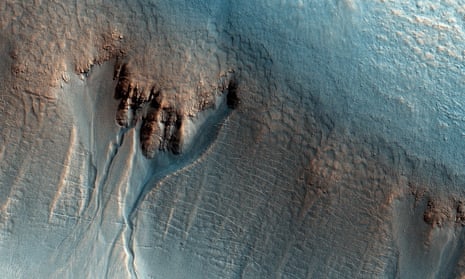Ancient lakes that came and went over millions of years in the Gale crater basin on Mars may have persisted long enough for life to evolve in them, researchers have said.
Nasa scientists analysed fresh images sent back from the Curiosity rover and found evidence of lakes in the basin that lasted for up to 10,000 years at a time – potentially long enough to support life.
The lakes formed as the water table rose and rivers trickled down to the lowest point in the crater, only for them to dry up again when the water table subsided. Even though the lakes disappeared, the soil may have remained damp.
Maps of Mars taken from orbiting spacecraft have shown that lakes once dotted the surface of the red planet. The latest images from the Curiosity rover confirm that similar pools of water once dominated the landscape of the Gale crater, too.
The Curiosity rover is trundling around the lower part of Mount Sharp, an extraordinary mountain of layered sediments that rises up three miles (5km) from the middle of the Gale crater. Armed with the latest images from the rover, scientists pieced together how features on the terrain arose.
“The sedimentary layers that make up the lower part of Mount Sharp were deposited in a lake environment,” said Sharon Wilson, a geologist at the Smithsonian Institution in Washington DC and senior author of a Science study describing the results. “The material was transported from the crater interior by rivers on ancient Mars.”
Images of the sediments show that gravel and sand that eroded off the northern wall of the crater were carried south in shallow streams that formed deltas at the boundary of an ancient lake. Although the lakes were not permanent, some may have existed for 10,000 years.
“On Earth we know that water is an essential ingredient for forming or sustaining life. If the same was true for Mars, the presence of long-standing lakes could have been an ideal environment for life to take hold,” Wilson told the Guardian. But she added: ”If there was life on ancient Mars, it would have to adapt to survive as the climate evolved over time.”
The striking presence of Mount Sharp itself is explained by layer upon layer of sediment being laid down on the crater floor, and then being eroded by Martian winds to leave the central standing feature.
Marjorie Chan, a geologist at the University of Utah, said the growing picture of water on Mars, from the existence of ancient lakes, to watery brines flowing today down crater walls and canyons, makes the planet look a more hospitable place.
“I’ve always thought that it would be impossible for there to be life on Mars, but the pendulum for me is starting to swing,” she said. “I hope that we might find it, but it’s going to be tough to unravel.”
In an accompanying article in Science, Chan asked whether Mars could have had pure water devoid of any lifeforms.
“Although there is not yet definitive evidence for extraterrestrial life, the geologic results show that there were the key ingredients of water and places where water could have been accessible for microbial life to originate and evolve. Thus, the geology of Mars still holds the tantalising possibility that extraterrestrial life might exist or have been preserved, because the evidence of water is so plentiful.
“On Earth it is likely that any and all near-surface waters for the past 3.5bn years have been literally contaminated with some microbial life. Would Mars have had pure abiotic waters? The more the geology looks like Earth, the more likely it seems that some life forms could have developed in the Martian waters.”
